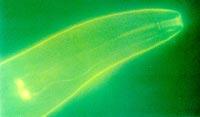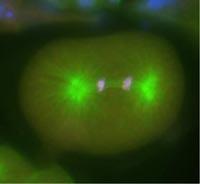Nobel Prize for Medicine 2002 announced
2002/10/07 Galarraga Aiestaran, Ana - Elhuyar Zientzia

The cells that form the human body are of hundreds of types, all of them derived from a fertilized cell. In the embryonic and fetal phases, on the one hand, the number of cells increases considerably, and on the other, the cells mature and specialize in the formation of organs and tissues. Numerous new cells are also formed in the adult body. At the same time, for the number of cells in the body to be adequate, cells die. This death is scheduled in advance, so there is no imbalance.
C. elegans, cell separation model
To understand these processes, the winners have worked with the worm Caenorhabditis elegans. In fact, Sydney Brenner was the first person to work with this nematode, seeing that it is ideal for analyzing cell separation and organ development. C. elegans has a length of one millimeter, requires little time to grow and, being transparent, the cell division can be seen directly through a microscope. Also, in 1974 Brenner showed that a chemical, called EMS, can produce mutations in the nematode genome. Each mutation is associated with specific genes and has specific repercussions in the development of the organs. Brennner therefore combined the microscopic study of cell division with genetic analysis, and received the award for the findings that followed this combination.
Monitoring of cell lineage

John Sulston continued Brenner's work and developed techniques to study the cellular division of nematode. In a work published in 1976, Sulstone showed in which cells of C. elegans came cells from a part of the nervous system. In addition, it showed that cells, in their division and separation, always follow the same rule. He found that 1,090 cells are formed from the fertilized egg of C. elegans, of which 131 die, and that the adult nematode always has 959 cells.
From these research it was concluded that cell death is programmed and predictable in living beings, since it always follows the same rule. In addition, it demonstrated for the first time a mutation of the genes involved in programmed death. Among the genes involved in cell death is the nuc-1 gene. Sulstone showed that the protein that encodes this gene is essential to remove DNA from the cell that has died.
Identification of death genes
Robert Horvitz advanced through the previous two. In his research begun in the 1970s, he used C. elegans to learn about the existence of a genetic program that controlled cell death. According to its publication in 1986, ced-3 and ced-4 genes are essential for cell death. Subsequently, it found that the CED-9 gene protected from death and identified other genes related to cell death. He also observed the presence of this type of genes in humans.
Importance of cell death
The work carried out by these researchers has allowed others to identify the genes that currently control the death of human cells. Understanding the programming of cell death is essential to know the essence of certain diseases. For example, it helps to understand how certain viruses and bacteria attack human cells.

Scientists know that in AIDS, after suffering an infarction and in some degenerative diseases, cells are lost because they accelerate the process of death. In other diseases, the opposite occurs, such as cancer and autoimmune situations, the cells that should die are still alive.
In the fight against cancer, strategies that promote cell suicide are being tested and there are many studies related to cell death. It is not surprising, therefore, that the Prize of Physiology and Medicine is granted to these three researchers, who are the basis of the investigations that are being carried out today.

Gai honi buruzko eduki gehiago
Elhuyarrek garatutako teknologia






